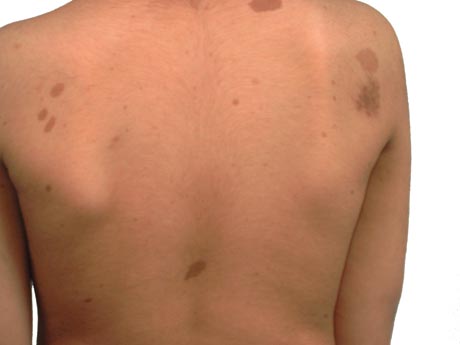Resumo
Definição
História e exame físico
Principais fatores diagnósticos
- história familiar de NF1
- dor, qualquer local
- déficits neurológicos: atraso motor macroscópico, falta de coordenação geral, problemas de desempenho escolar
- comprometimento visual
- comprometimento das interações sociais
- pele: manchas café-com-leite, sardas axilares, xantogranulomas juvenis cutâneos, neurofibromas
- cabeça e pescoço: divisões do nervo trigêmeo com neurofibroma plexiforme difuso unilateral
- oftalmológicos: comprometimento da visão, palidez do disco óptico, nódulos de Lisch na íris
- sistema nervoso central: sinais de hidrocefalia, tumores cerebrais e/ou anomalias cerebelares
- sistema nervoso periférico: massa palpável no pescoço, plexos braquiais, virilha, canal de Hunter ou fossas poplíteas
- esqueléticos: displasia tibial ou pseudoartrose, displasia da asa do esfenoide, pectus excavatum ou carinatum, geno varo ou valgo, tornozelo valgo, pés planos
- gastrointestinais: constipação grave, obstipação, dor abdominal, sangramento gastrointestinal
- vasculares: problemas neurológicos, dor abdominal (e/ou hemorragia)
- transtorno do espectro autista
- vasculares: hipertensão
Fatores de risco
- genitor com neurofibromatose do tipo 1 (NF1)
- trauma grave por esmagamento
Investigações diagnósticas
Primeiras investigações a serem solicitadas
- ressonância nuclear magnética (RNM) e/ou tomografias computadorizadas (TCs)
- tomografia por emissão de pósitrons (PET)
- biópsia
- teste genético para confirmar a mutação da neurofibromatose do tipo 1 (NF1)
Algoritmo de tratamento
feocromocitoma
tumor maligno da bainha dos nervos periféricos
neurofibromas: não-cutâneos
cutânea
cefaleia
sistema nervoso
olho
oral
esquelético
vascular
gastrointestinal
hematopoiético
psicológico
relacionado à gestação
Colaboradores
Autores
D. Gareth Evans, MD, FRCP
Professor of Medical Genetics and Cancer Epidemiology
Genomic Medicine
School of Medicine
University of Manchester
Manchester
UK
Declarações
DGE is an author of several studies referenced in this topic. He receives consultancies from Astrazeneca, Springworks, and Recursion. These may impact on recommendations for MEKi treatment.
Agradecimentos
Professor D. Gareth Evans would like to gratefully acknowledge Dr Vincent M. Riccardi, a previous contributor to this topic.
Declarações
VMR is an author of several studies referenced in this topic.
Revisores
Bruce R. Korf, MD, PhD
Professor
Department of Genetics
University of Alabama at Birmingham
Birmingham
AL
Declarações
BRK declares that he has no competing interests.
Patrick Morrison, MD
Consultant in Clinical Genetics
Department of Medical Genetics
Belfast HSC Trust
Belfast
UK
Declarações
PM declares that he has no competing interests.
Edward S. Tobias, BSc (Hons), MBChB, MRCP (UK), PhD
Clinical Senior Lecturer and Honorary Consultant in Medical Genetics
Institute of Medical Genetics
Yorkhill Hospital
University of Glasgow
Scotland
UK
Declarações
EST declares that he has no competing interests.
Créditos aos pareceristas
Os tópicos do BMJ Best Practice são constantemente atualizados, seguindo os desenvolvimentos das evidências e das diretrizes. Os pareceristas aqui listados revisaram o conteúdo pelo menos uma vez durante a história do tópico.
Declarações
As afiliações e declarações dos pareceristas referem--se ao momento da revisão.
Referências
Principais artigos
Riccardi VM. Neurofibromatosis: phenotype, natural history and pathogenesis. 2nd ed. Baltimore, MD: Johns Hopkins University Press; 1992.
National Institutes of Health consensus development conference statement. Bethesda, MD, July 13-15, 1987. Neurofibromatosis. 1988;1(3):172-8.Texto completo Resumo
Mulvihill JJ, Parry DM, Sherman JL, et al. Neurofibromatosis 1 (Recklinghausen disease) and neurofibromatosis 2 (bilateral acoustic neurofibromatosis): an update. Ann Intern Med. 1990 Jul 1;113(1):39-52. Resumo
Rodrigues LO, Batista PB, Goloni-Bertollo EM, et al. Neurofibromatoses: part 1 - diagnosis and differential diagnosis. Arq Neuropsiquiatr. 2014 Mar;72(3):241-50. Resumo
Messiaen LM, Callens T, Mortier G, et al. Exhaustive mutation analysis of the NF1 gene allows identification of 95% of mutations and reveals a high frequency of unusual splicing defects. Hum Mutat. 2000;15(6):541-55. Resumo
Listernick R, Ferner RE, Liu GT, et al. Optic pathway gliomas in neurofibromatosis-1: controversies and recommendations. Ann Neurol. 2007 Mar;61(3):189-98. Resumo
Lammert M, Friedman JM, Kluwe L, et al. Prevalence of neurofibromatosis 1 in German children at elementary school enrollment. Arch Dermatol. 2005;141:71-4.Texto completo Resumo
Evans DG, Baser ME, McGaughran J, et al. Malignant peripheral nerve sheath tumours in neurofibromatosis 1. J Med Genet. 2002 May;39(5):311-4. Resumo
Artigos de referência
Uma lista completa das fontes referenciadas neste tópico está disponível para os usuários com acesso total ao BMJ Best Practice.

Diagnósticos diferenciais
- Neurofibromatose do tipo 2 (NF2)
- Síndrome de McCune-Albright
- Manchas café-com-leite familiares
Mais Diagnósticos diferenciaisDiretrizes
- Selumetinib for treating symptomatic and inoperable plexiform neurofibromas associated with type 1 neurofibromatosis in children aged 3 and over
- Revised diagnostic criteria for neurofibromatosis type 1 and Legius syndrome: an international consensus recommendation
Mais DiretrizesConectar-se ou assinar para acessar todo o BMJ Best Practice
O uso deste conteúdo está sujeito ao nosso aviso legal